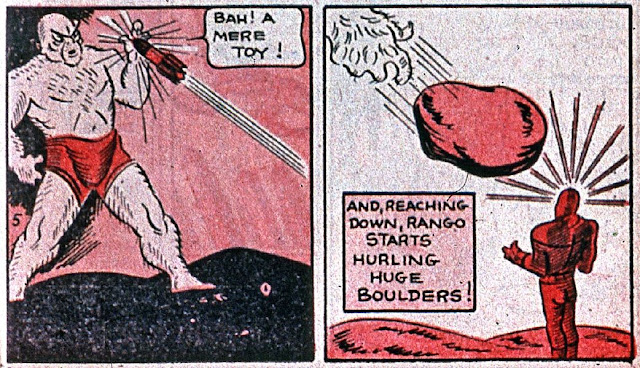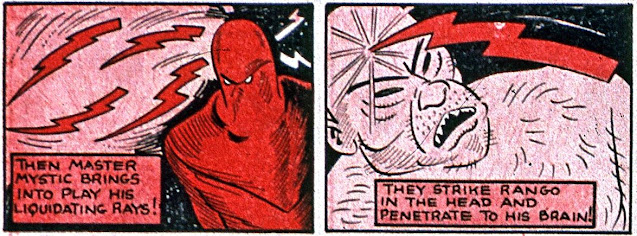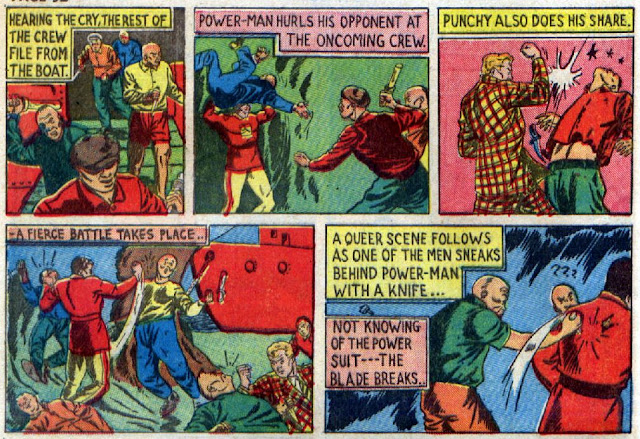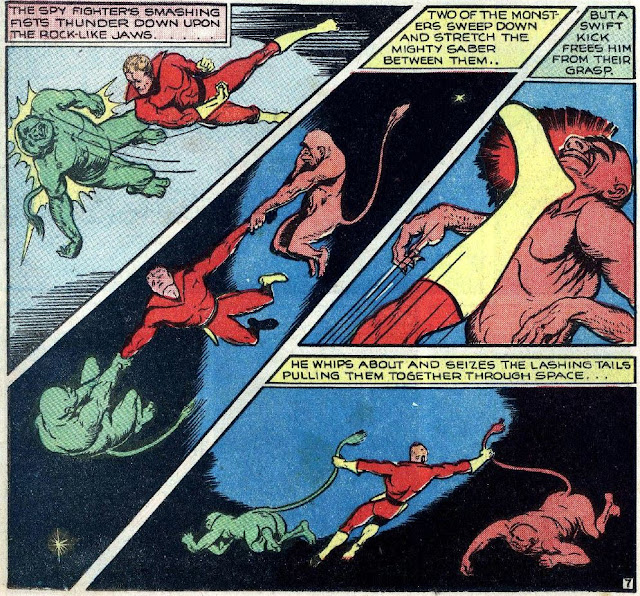More real people and their analogs. Lotta Hitlers in this one.
Adolf Hitler:
Hitler analogs c.1940 were often quite visually distinct from the actual man. Samson foe and dictator of Ratonia Dragor honestly looks more like a bald Stalin, and you might be excused for thinking that he was more of a pastiche of all extant dictators. The real clue is in the invasion of Belgium. (Fantastic Comics 002, 1940)
Meanwhile this as-yet unnamed dictator of the future super-nation of Russmany is a pretty clear Hitler-alike. (Fight Comics 001, 1940)
Misc Minor Appearances:
Hitler-alike dispatches the Tankonaut to sow terror in the US. (Exciting Comics 005, 1940)
Hitlerian dictator Rigo funds Samson foe Kilgor's robot army. (Fantastic Comics 006, 1940)
Benito Mussolini:
He doesn't actually appear in the comic but "Gasolini" is one of the better dumb stand-in names I have seen for Mussolini. Weirdly, the Dictator mentioned above is so generic that he's not really enough of a reference to any one person to include here. (Fantastic Comics 010, 1940)
Depicted with his pal
Hitler as a background gag in a room full of faux Mayan statuary. (Fantoman 003, 1940)
Fiorello Laguardia:
At this point it's worth noting any time that a generic Mayor of New York City shows up, just to have a record of them. (Fantastic Comics 011, 1940)
Franklin D Roosevelt:
Misc Minor Appearances:
Meets up with Dr John "Son of the Gods" Thesson to discuss the threat of the Tankonaut. (Exciting Comics 005, 1940)
Confers with Thesson and a panel of others about the threat of the Invincible Five (Exciting Comics 006, 1940)
Briefly kidnapped by super-gangster Rip-the-Blood, rescued by Stardust the Super Wizard (Fantastic Comics 002, 1940)
Henry Ford:
Motor king "Henry Lord" is kidnapped by the Miracle Men (Fantastic Comics 005, 1940)
Hollywood Crowd Scenes:
Comic strip "Olly of the Movies", about young actress Olive Lane's travails in Hollywood (seen here as a comic book reprint) is chock full of cameos - and under actual names! Marie Dressler, Mae West, Greta Garbo, Joan Crawford and Jimmy Durante are the ones named, but there are a whole swath (that I am not qualified to identify) in that second panel alone. (Famous Funnies 006, 1935)
Saladin:
Every Crusader hero eventually has to meet Saladin and the Golden Knight is no exception. The creators always have to balance the fact that they obviously think that Saladin is very cool with the idea that he is supposed to be the villain and this is a story where it is not quite pulled off: Saladin spares the Golden Knight because he is such a valiant battler and shows him great hospitality, while the Knight wanders around all surly and churlish talking about how he'd like to kill everyone present. Saladin definitely comes off better in the interaction. (Fantastic Comics 002, 1940)


Saladin and the Golden Knight meet up again a few issues later and the encounter ends with the Golden Knight killing Saladin, a wildly ahistoric event but not a unique one, as you might see if I ever work my way through the hundreds of Real Person in Comics entries I have in spreadsheet form. For the record, Saladin died of a fever, still in control of Jerusalem, a full year after the Third Crusade ended. (Fantastic Comics 008, 1940)
Selection of Old-Time Boxers:
Boxer and heavyweight champ Kayo Kirby has a stress dream in which he meets and is beaten up by successive old-time champs John L. Sullivan...
... Gentleman Jim Corbett...
... and Bob Fitzsimmons (with special appearance by his wife Rose).
He also receives some training from old-time boxer Charley Mitchell, not that it does him much good against the spectres of his own mind. (Fight Comics 009, 1940)
Unknown:
Given that he was kidnapped immediately following "Henry Lord", above, there is a strong possibility that "John Rancab" is also a stand-in name. As "Bacnar" does not appear to be a name and the only John Branca I can find was born in 1950, I am stumped - is it just a bad anagram of "banker"? Maybe. (Fantastic Comics 005, 1940)
































































